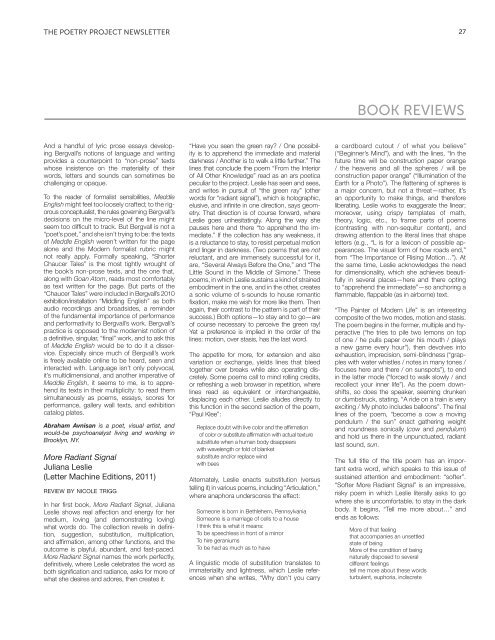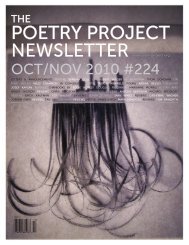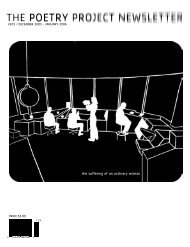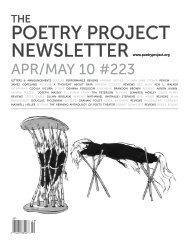You also want an ePaper? Increase the reach of your titles
YUMPU automatically turns print PDFs into web optimized ePapers that Google loves.
THE POETRY PROJECT NEWSLETTER27BOOK REVIEWSAnd a handful of lyric prose essays developingBergvall’s notions of language and writingprovides a counterpoint to “non-prose” textswhose insistence on the materiality of theirwords, letters and sounds can sometimes bechallenging or opaque.To the reader of formalist sensibilities, MeddleEnglish might feel too loosely crafted; to the rigorousconceptualist, the rules governing Bergvall’sdecisions on the micro-level of the line mightseem too difficult to track. But Bergvall is not a“poet’s poet,” and she isn’t trying to be: the textsof Meddle English weren’t written for the pagealone and the Modern formalist rubric mightnot really apply. Formally speaking, “ShorterChaucer Tales” is the most tightly wrought ofthe book’s non-prose texts, and the one that,along with Goan Atom, reads most comfortablyas text written for the page. But parts of the“Chaucer Tales” were included in Bergvall’s 2010exhibition/installation “Middling English” as bothaudio recordings and broadsides, a reminderof the fundamental importance of performanceand performativity to Bergvall’s work. Bergvall’spractice is opposed to the modernist notion ofa definitive, singular, “final” work, and to ask thisof Meddle English would be to do it a disservice.Especially since much of Bergvall’s workis freely available online to be heard, seen andinteracted with. Language isn’t only polyvocal,it’s multidimensional, and another imperative ofMeddle English, it seems to me, is to apprehendits texts in their multiplicity: to read themsimultaneously as poems, essays, scores forperformance, gallery wall texts, and exhibitioncatalog plates.Abraham Avnisan is a poet, visual artist, andwould-be psychoanalyst living and working inBrooklyn, NY.More Radiant SignalJuliana Leslie(Letter Machine Editions, 2011)review by nicole triggIn her first book, More Radiant Signal, JulianaLeslie shows real affection and energy for hermedium, loving (and demonstrating loving)what words do. <strong>The</strong> collection revels in definition,suggestion, substitution, multiplication,and affirmation, among other functions, and theoutcome is playful, abundant, and fast-paced.More Radiant Signal names the work perfectly,definitively, where Leslie celebrates the word asboth signification and radiance, asks for more ofwhat she desires and adores, then creates it.“Have you seen the green ray? / One possibilityis to apprehend the immediate and materialdarkness / Another is to walk a little further.” <strong>The</strong>lines that conclude the poem “From the Interiorof All Other Knowledge” read as an ars poeticapeculiar to the project. Leslie has seen and sees,and writes in pursuit of “the green ray” (otherwords for “radiant signal”), which is holographic,elusive, and infinite in one direction, says geometry.That direction is of course forward, whereLeslie goes unhesitatingly. Along the way shepauses here and there “to apprehend the immediate.”If the collection has any weakness, itis a reluctance to stay, to resist perpetual motionand linger in darkness. (Two poems that are notreluctant, and are immensely successful for it,are, “Several Always Before the One,” and “<strong>The</strong>Little Sound in the Middle of Simone.” <strong>The</strong>sepoems, in which Leslie sustains a kind of strainedembodiment in the one, and in the other, createsa sonic volume of s-sounds to house romanticfixation, make me wish for more like them. <strong>The</strong>nagain, their contrast to the pattern is part of theirsuccess.) Both options—to stay and to go—areof course necessary to perceive the green ray!Yet a preference is implied in the order of thelines: motion, over stasis, has the last word.<strong>The</strong> appetite for more, for extension and alsovariation or exchange, yields lines that bleedtogether over breaks while also operating discretely.Some poems call to mind rolling credits,or refreshing a web browser in repetition, wherelines read as equivalent or interchangeable,displacing each other. Leslie alludes directly tothis function in the second section of the poem,“Paul Klee”:Replace doubt with live color and the affirmationof color or substitute affirmation with actual texturesubstitute when a human body disappearswith wavelength or fold of blanketsubstitute and/or replace windwith beesAlternately, Leslie enacts substitution (versustelling it) in various poems, including “Articulation,”where anaphora underscores the effect:Someone is born in Bethlehem, PennsylvaniaSomeone is a marriage of cells to a houseI think this is what it means:To be speechless in front of a mirrorTo hire geraniumsTo be had as much as to haveA linguistic mode of substitution translates toimmateriality and lightness, which Leslie referenceswhen she writes, “Why don’t you carrya cardboard cutout / of what you believe”(“Beginner’s Mind”), and with the lines, “In thefuture time will be construction paper orange/ the heavens and all the spheres / will beconstruction paper orange” (“Illumination of theEarth for a Photo”). <strong>The</strong> flattening of spheres isa major concern, but not a threat—rather, it’san opportunity to make things, and thereforeliberating. Leslie works to exaggerate the linear;moreover, using crispy templates of math,theory, logic, etc., to frame parts of poems(contrasting with non-sequitur content), anddrawing attention to the literal lines that shapeletters (e.g., “L is for a lexicon of possible appearances.<strong>The</strong> visual form of how roads end,”from “<strong>The</strong> Importance of Rising Motion…”). Atthe same time, Leslie acknowledges the needfor dimensionality, which she achieves beautifullyin several places—here and there optingto “apprehend the immediate”—so anchoring aflammable, flappable (as in airborne) text.“<strong>The</strong> Painter of Modern Life” is an interestingcomposite of the two modes, motion and stasis.<strong>The</strong> poem begins in the former, multiple and hyperactive(“he tries to pile two lemons on topof one / he pulls paper over his mouth / playsa new game every hour”), then devolves intoexhaustion, imprecision, semi-blindness (“grappleswith water whistles / notes in many tones /focuses here and there / on sunspots”), to endin the latter mode (“forced to walk slowly / andrecollect your inner life”). As the poem downshifts,so does the speaker, seeming drunkenor dumbstruck, stating, “A ride on a train is veryexciting / My photo includes balloons”. <strong>The</strong> finallines of the poem, “become a cow a movingpendulum / the sun” enact gathering weightand roundness sonically (cow and pendulum)and hold us there in the unpunctuated, radiantlast sound, sun.<strong>The</strong> full title of the title poem has an importantextra word, which speaks to this issue ofsustained attention and embodiment: “softer”.“Softer More Radiant Signal” is an impressive,risky poem in which Leslie literally asks to gowhere she is uncomfortable, to stay in the darkbody. It begins, “Tell me more about…” andends as follows:More of that feelingthat accompanies an unsettledstate of beingMore of the condition of beingnaturally disposed to severaldifferent feelingstell me more about these wordsturbulent, euphoria, indiscrete
















